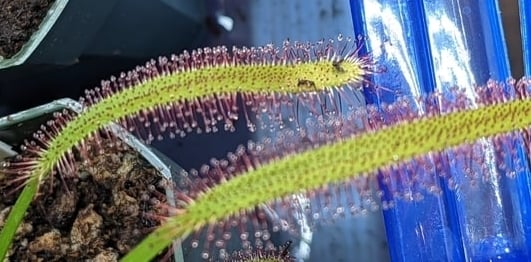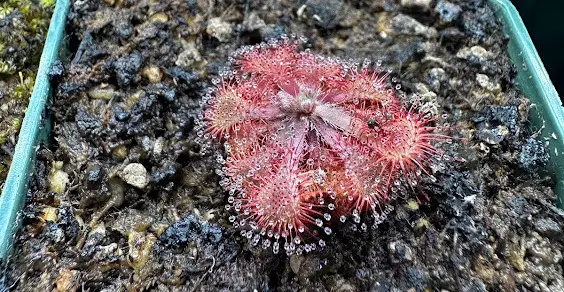As a beginner carnivorous plant owner, feeding your plant can seem overwhelming. However, the process is not very hard and carnivorous plants benefit a lot from it. In this article I will explain step by step how to feed your Venus fly trap, sundew, butterworts or pitcher plant.
First, let’s start with the basics. Carnivorous plants capture insects to supplement their diet. They produce food through photosynthesis and extract extra nutrients from insects.
Technically, carnivorous plants do not need insects to be healthy, however, insects do offer great benefits like increased growth, propagation, and healthier looks.
Outdoor plants usually capture their own insects, and do not require feeding. On the other hand, indoor plants might need some help capturing prey.
Here are the food options to consider:
- Live or dead insects such as ants, flies, gnats, crickets, fruit flies, etc
- Freeze dried insects like crickets, mealworms, bloodworms: This bugs are dehydrated. To rehydrate them, just add a few drops of distilled water and let the insect absorb it for 3-5 min. Then, pat it dry before feeding to your plant.
- Dried crickets to feed carnivorous plants: https://amzn.to/34QEnKv

- Freeze-dried mealworms for carnivorous plants: https://amzn.to/3B9V4i0

- Dried crickets to feed carnivorous plants: https://amzn.to/34QEnKv
- Fish food: This option has plenty of nutrients. You can break into pieces and place them in the leaves or dilute with distilled water to create a paste.
- Diluted Maxsea fertilizer
 : To feed you plant you dissolve 1/4 of a teaspoon of Maxsea fertilizer in a gallon of distilled water. Then you can add a few drops inside pitchers or right on top of the leaves of Venus fly trap, sundew, or butterworts.
: To feed you plant you dissolve 1/4 of a teaspoon of Maxsea fertilizer in a gallon of distilled water. Then you can add a few drops inside pitchers or right on top of the leaves of Venus fly trap, sundew, or butterworts.
Never feed human food to your carnivorous plant.
Carnivorous plants can’t process such complex foods. If you make this mistake, the food will rot and the leaf and potentially surrounding leaves can wither.
This article  can tell you a lot more of the benefits for each food option. Also, I make recommendations below for each plant type.
can tell you a lot more of the benefits for each food option. Also, I make recommendations below for each plant type.
How to Feed Venus Fly Trap
Feed Venus fly traps once every 2-6 weeks. You will only need to feed a single leaf of the plant with one bug. You can feed more, but a single insect is enough to provide all the needed nutrients.
When selecting an insect, make sure the bug can fit inside the trap completely when the trap is closed. Preferably, use an insect that is 1/3 of the size of the trap.
Flies, ants, small crickets and spiders are some good candidates.
Feeding Live Bugs
Feeding live insects to a Venus fly trap is very easy. Place the insects inside the trap and make sure you touch the trigger hairs inside the leaf. There are three thin filaments in each lobe, each of them is. a trigger hair. Touch any of them twice within a few seconds and the trap will close.
You have to be fast as dropping the insects and activating the trap before the bug scapes.
The plant will then close, trap the insect and start producing enzymes to consume the food.
Venus fly trap will take about 7 to 21 days to consume a small bug and even longer for large insects.
Feeding Dead Insects
Using dead insects to feed your plants, does not require quick reflexes, you can just place them in a leaf and then touch the trigger hairs. The plant will close, but it won’t start digesting the bug.
Venus fly traps are very careful at selecting prey, they only consume live insects.
For this reason, you must trick the plant into believing it caught a live insect. You will need to press both sides of the trap together. Do a tapping motion several times, approximately 20-60 times. When you tap, the trigger hairs sense movement and the plant sets its digestive motions and starts producing fluids.
Avoid feeding Venus fly traps when they are dormant in the winter, the next couple of weeks following a repotting, or if you plant is looking down or sick.

Guide to Feed Sundews (Drosera)
Sundews can consume tons of small insects at a time. They are very good at controlling gnat populations.
Feeding sundews is straightforward. Use a small bug, preferably an ant, fly, gnat, or mosquito and stick it to a leaf. The bug can be dead or alive.
Avoid large insects that will be left unconsumed for long periods of time, like a big cricket or beetle.
A single bug is enough to feed the whole plant. If you add multiple bugs, make sure you only place them in one or two leaves as sometimes leaves might turn black after feeding.
Feed your sundew once every 2-4 weeks for best results.
The image below is one of my sundews, it shows the recommended size for selecting insects. Small sundews can consume fruit flies and gnats.

Fun fact: Some sundews curl their leafs to help with digestion.
Avoid feeding your sundew if it is dormant, if you just repotted it, or if the plant is recovering from anything, like pests, for example.
Feeding Pitcher Plants: Nepenthes and Sarracenia
Nepenthes and Sarracenia can consume large amounts of insects at a time.
They trap bugs by attracting them with sweet nectar to the edge of their pitcher-shaped leaves. Those edges are very slippery and cause insects to fall and get stuff within the pitcher.
Feed pitcher plants by dropping live or dead insects inside the pitcher leaves. You can also use fish food, dehydrated bugs of diluted malsea fertilizer.
The fluid inside the pitchers breaks down the insect and helps with the absorption of nutrients.
Adding food in one or two pitchers is enough for the whole plant. You can repeat the feeding process once every 2-6 weeks.
There is no such thing as overfeeding nepenthes or sarracenia. However, if you grow them indoors, keep in mind that tons of dead insects decomposing inside pitcher can emit some odor (if the volume is substantial).
Feel free to feed your plant all year round.
When you feed it, keep at eye in the pitchers, some food can make the pitchers wither. Observing the health of the plant will help you evaluate its effectiveness.
Sometimes pitcher plants stop producing fluids inside their leaves due to improper growing conditions. The lack of fluid won’t stop the digestion of the insects, but will slow it down substantially. If you plant is not producing liquid, read this article to resolve it .
.
How to Feed Butterworts
Butterworts or pinguicula are very effective at capturing tiny insects with their sticky leaves.
Feed butterworts by sticking tiny insects to its leaves. Gnats, ants, and fruit flies are great candidates.
Mature plants might be able to consume small flies, but it will all depend on the size of the plant.
You can also use diluted Maxsea fertilizer, adding a drop in the leaves. However, be careful and do not drop into the soil.
Use one or two bugs in every feeding and repeat the process every 2-6 weeks.
Avoid feeding when the plant is dormant.
